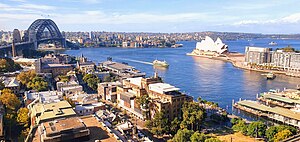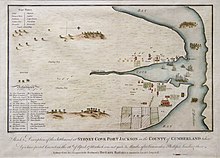Sydney Cove(Eora:Warrane[1]) is a bay on the southern shore of Sydney Harbour, one of several harbours inPort Jackson,on the coast ofSydney,New South Wales.Sydney Cove is a focal point for community celebrations, due to its central Sydney location between theSydney Opera Houseand theSydney Harbour Bridge.

Sydney Cove was the site of theFirst Fleet's landing on 26 January 1788 and the subsequent raising of theUnion Jack,a seminal date inAustralian historynow marked asAustralia Day.

History
editTheEoraname for Sydney Cove was recorded by several early settlers of theFirst Fleetvariously spelt as Warrane,War-ran,WarrangandWee-rong.The spot is of great significance, as the first meeting place between Eora people and Europeans. Beforecolonisation of the area,Eora men speared fish from the shoreline, and women line-fished from theirnowies(canoes).[2]
Sydney Cove was named after the BritishHome Secretary,the 1st Baron Sydney(who was later created 1stViscount Sydneyin 1789). It was the site chosen byCaptainArthur Phillip,RNbetween 21 and 23 January 1788 for the British penal settlement which is now the city ofSydney,and where possession of New South Wales was formally declared on 26 January (now commemorated as Australia Day).[3]Today, the exact site where the flag was planted is unmarked, being a spot near the bottom of Bethel Steps, The Rocks (behind the south end of the present Overseas Passenger Terminal)[4]This site on the west side of the Cove is confirmed by a 1789 letter by John Campbell.[5]
Phillip had been instructed to establish the settlement atBotany Bay,a large bay further south of Sydney Cove which had been discovered by LieutenantJames Cookduring his voyage of discovery in 1770, and was recommended by the eminent botanistSir Joseph Banks,who had accompanied Cook, as a suitable site for a settlement. But Phillip discovered that Botany Bay offered neither a secureanchoragenor a reliable source of fresh water. Sydney Cove offered both of these, being serviced by a freshwater creek which was soon to be known as theTank Stream.[6]
It must have been like entering paradise on that summer afternoon when the sea-won convoy passed through the dun and barren headlands into the untouched harbour – the water brilliantly blue, the shores high and wooded without being precipitous, a scattering of islands, sandy beaches, the trees shimmering under the sun.
The site of the settlement was Sydney Cove. It was one of the smaller inlets, chosen because it had fresh water and good anchorage for ships close into the land. The Governor's working party had cleared a camping ground beside the creek, which stole silently along through a very thick wood, the stillness of which had then for the first time since the Creation, been interrupted by the rude sound of the labourer's axe.[7]
Sydney Cove Medallion
editA sample of the dark grey clay of Sydney Cove was collected by Governor Phillip and given to SirJoseph Banks,who gave it to pottery makerJosiah Wedgwoodto test for suitability for making pottery. Wedgwood found it excellent and made a commemorative medal that became known as the Sydney Cove Medallion.[8][9][10]
Today
editThe cove isdual-namedas Warrane, the name by which it was known by theEorapeople.[11]
TheTank Streamis encased in a concrete drain beneath the streets of the central business district[12]and all nativebushlandhas been cleared. The head of the cove is occupied by theCircular Quayferry terminal. OnBennelong Pointat the northern end of the eastern shore of the cove stands theSydney Opera House.On the western shore is the historic district known asThe Rocks.[13]
Sydney Cove is a focal point for community celebrations, due to its central Sydney location between theSydney Opera Houseand theSydney Harbour Bridge.It is also one of the main congregation points for Sydney New Year's Eve[14]and Australia Day events.[15]
See also
editReferences
edit- ^"Sydney Cove".Geographical Names Board.Archived fromthe originalon 12 June 2021.Retrieved16 July2022.
- ^"Barani".Sydney Cove / Warrane.Retrieved5 July2021.
- ^Discover Sydney: Sydney's European History.TravelOnline. Retrieved 10 May 2018
- ^Barlass, Tim (16 July 2022)."Why the City of Sydney pays for a British flag to fly near Circular Quay".The Sydney Morning Herald.Retrieved22 January2023.
- ^NSW State Library
- ^Sydney Water: The Tank Stream,2010 leaflet
- ^Eldershaw, Flora;Barnard, Marjorie(1938).Phillip of Australia: an account of the settlement at Sydney Cove, 1788–92.Australia:Angus and Robertson.
published under their joint nom de plume M. Barnard Eldershaw
- ^Josiah Wedgwood's Sydney Cove MedallionArchived21 March 2012 at theWayback Machine,National Museum of Australia.
- ^National Museum of AustraliaSydney Cove Medallion from the museum's Collections Search.
- ^Robert J. King, "'Etruria': the Great Seal of New South Wales", Journal of the Numismatic Association of Australia, vol.5, October 1990, pp.3-8.[1]Archived29 March 2020 at theWayback Machine
- ^"Language".Barani.12 August 1965.Retrieved5 July2021.
- ^Hoh, Amanda.The Tank Stream: A historical walk along Sydney's first water supply.ABC News,7 November 2016. Retrieved 10 May 2018
- ^Sydney Street Directory.Sydney:UBD.1999. p. 1.ISBN0-7319-1055-9.
- ^Gorrey, Megan (9 December 2021)."Harbour city to shine beneath New Year's Eve fireworks".The Sydney Morning Herald.Retrieved10 December2021.
- ^"What was on".Australia Day Council of NSW.Retrieved7 August2022.
Further reading
edit- D. Manning Richards.Destiny in Sydney:An epic novel of convicts, Aborigines, and Chinese embroiled in the birth of Sydney, Australia.First book in Sydney series. Washington DC: Aries Books, 2012.ISBN978-0-9845410-0-3